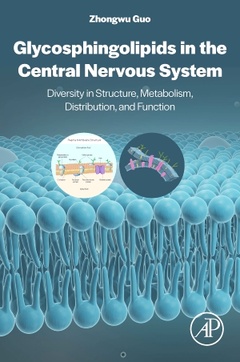Glycosphingolipids in the Central Nervous System Diversity in Structure, Metabolism, Distribution, and Function
Auteur : Guo Zhongwu

Glycosphingolipids in the Central Nervous System: Diversity in Structure, Metabolism, Distribution, and Function comprehensively covers progress made in the discovery, profiling and understanding of the metabolism, function and functional mechanism of GSLs in the CNS ?as well as their synthesis, relationships with and therapeutic applications to neurodegenerative disorders, and related CNS diseases. Due to the important roles of GSLs in the CNS and various CNS-related diseases, the interest in these biomolecules is growing. GSLs are the principal glycolipids on the cell surface and an essential constituent of the cell membrane.
They are widespread, but especially enriched in the central nervous system (CNS) in vertebrates. The diversity of GSL structures forges the molecular foundation for their broad spectrum of activity.
Research in the Guo laboratory is at the interface of chemistry, chemical biology, and biomedical sciences. Its research projects range from the development of novel synthetic methodologies for complex carbohydrates, glycolipids and other glycoconjugates to their biological and medical applications. The methodologies include both chemical and chemoenzymatic syntheses, and the synthetic targets range from biologically important complex oligosaccharides to natural and functionalized glycoconjugates, such as glycosylphosphatidylinositols (GPIs), glycosphingolipids (GSLs), and glycoproteins. The synthesized molecules are employed to study and gain insights into the structures, functions, and action mechanisms of carbohydrates and glycoconjugates in various physiological and pathological processes, such as the interactions of GPIs and GSLs with the cell membrane and the functional roles of GPIs and GSLs in human diseases. New mass spectrometry-based methods are developed to explore GSL-omics of the central nerve system and its relationship with human diseases. Glycoconjugates are also explored for the development of new cancer immunotherapies, including therapeutic cancer vaccines.
- Presents a systematic review of literature and potential future developments in Glycosphingolipid research
- Highlights interdisciplinary interplay between various aspects of the neuronal system and its structural and functional properties
- Provides an overview, general trends, cases studies, summaries and future implications
Date de parution : 03-2024
Ouvrage de 454 p.
15x22.8 cm



